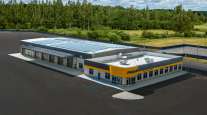Executive Editor
Industry Ready to Meet Demand for Last-Mile Delivery Option

ATLANTA — A combination of better equipment, increasing governmental pressure and improving economics is aligning to make a case that alternative-power options can make practical sense to meet the trucking industry’s growing last-mile delivery needs, experts said.
“The writing is on the wall,” Mike Hasinec, vice president of maintenance support for Penske Truck Leasing, said here during a panel discussion at the Technology & Maintenance Council’s annual meeting focused on how last-mile delivery services are changing fleet-maintenance management.
“It appears in the very near future major cities will demand that commercial vehicles operating in their limits will be powered by something other than a diesel or gasoline engine,” he said. “In many ways, when you think about it, it makes sense. When you look at the congestion, the stop density, the routes and the short distances that they travel in a given day, the infrastructure is very feasible and can support the technology.”
Penske's Mike Hasinec, VP of maintenance systems and support, at #TMC18 presenting on how last mile delivery solutions are transforming #fleetmaintenance management pic.twitter.com/KBBcRZ76jG — Penske Truck Leasing (@PenskeNews) March 6, 2018
And the external pressure to make it happen is coming from many sources, noted Thomas Dollmeyer, director of technology and engineering at Cummins Electrified Power. “Something different is happening now,” he said. “That change is really coming from the needs in urban areas, where the bulk of the last-mile activity happens,” he said. “Mayors are stepping up and saying, ‘I need some change in my city’ ” to address congestion and air quality. He noted that local governments can put in place regulations that federal governments cannot.
But despite that pressure, Dollmeyer noted that fleets still need to make a business case.
Visiting #TMC18 and curious if electric power from the Cummins Integrated Power Portfolio is right for you? Find out which applications are prime candidates for electrified powertrains: https://t.co/pGM2dENLTw — Cummins Engines (@CumminsEngines) March 6, 2018
“For this stuff to really take off, it needs to be profitable,” he said. “They need to be the solutions that we would prefer economically. Just being asked to do it by city councils really isn’t going to get us there.”
And he said the numbers are starting to make sense. “We are seeing that the technologies and the economics are starting to become positive in some applications,” Dollmeyer said.
Pointing to electrification, he said that the drayage, utility, regional haul, urban delivery and refuse sectors are leading segments in which electric power can be feasible from an economic and practical standpoint. “We anticipate that we will have good economics for city delivery applications very soon,” he said.
A vital element for this success also is good equipment, and it is here where original equipment manufacturers must make a commitment, Hasinec said.
“When you look at the OEMs, they have been somewhat reluctant to heavily invest in the technologies, to the resources,” he said, pointing specifically to the expense tied to developing the products.
Going forward, OEMs must make an engineering commitment to the products, something that was missing in, for example, hybrids that reached the market earlier in the decade, Dollmeyer said. Many of those vehicles were launched by startups, he noted, and lacked rigid developmental work.
OEMs also must commit to helping customers develop service plans for these alternative-power vehicles, noted Duane Lippincott, director of learning and development in corporate automotive engineering for UPS Inc.
“They are the experts — we need to leverage them to help our technicians,” he said, noting that training and help could be done online or via video, including, potentially, a YouTube channel with demonstrations on repairs.
Related to this is ensuring that the industry is ready when technologies arrive.
“How do we roll out ‘just in time’ training to the industry that’s not too early, not too late,” he said, noting that the industry “struggled a bit” during the early days of diesel particulate filters and selective catalytic reduction. “The technology was there before the training.”




